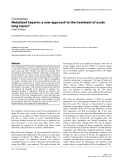


Approach to the acutely
-
This study aimed to evaluate the clinical manifestations, laboratory findings, and treatment outcomes in patients diagnosed with hypertriglyceridemia-induced acute pancreatitis (HTG-AP).
 6p
6p  vihizuzen
vihizuzen
 26-05-2025
26-05-2025
 2
2
 1
1
 Download
Download
-
Severe air pollution in Vietnam's tourism areas has become a significant economic issue in recent years. While many studies have found a link between population exposure to air pollution and poor health outcomes, short-term exposure to air pollutants in high-pollution zones can result in acute health consequences; thus, poor air quality jeopardizes visitors' health and well-being and threatens the tourism industry's sustainability.
 14p
14p  viyamanaka
viyamanaka
 06-02-2025
06-02-2025
 3
3
 2
2
 Download
Download
-
Guidelines and recommendations developed and/or endorsed by the American College of Rheumatology (ACR) are intended to provide guidance for particular patterns of practice and not to dictate the care of a particular patient.
 15p
15p  tramnamcodon_01
tramnamcodon_01
 28-03-2016
28-03-2016
 75
75
 3
3
 Download
Download
-
Tuyển tập các báo cáo nghiên cứu về y học được đăng trên tạp chí y học Critical Care giúp cho các bạn có thêm kiến thức về ngành y học đề tài: Nebulised heparin: a new approach to the treatment of acute lung injury?
 2p
2p  coxanh_4
coxanh_4
 27-10-2011
27-10-2011
 61
61
 4
4
 Download
Download
CHỦ ĐỀ BẠN MUỐN TÌM















